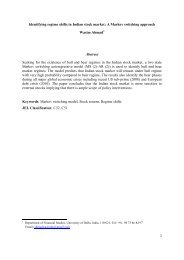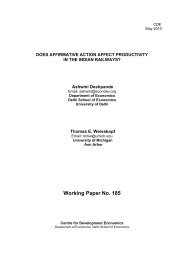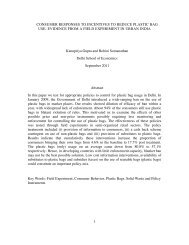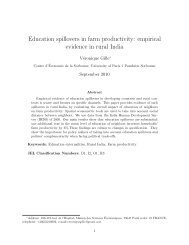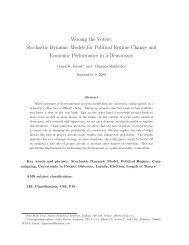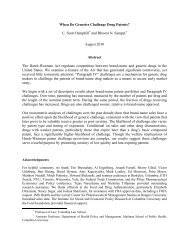Dismantling the Legacy of Caste - Centre For Development Economics
Dismantling the Legacy of Caste - Centre For Development Economics
Dismantling the Legacy of Caste - Centre For Development Economics
Create successful ePaper yourself
Turn your PDF publications into a flip-book with our unique Google optimized e-Paper software.
A variety <strong>of</strong> initiatives are intended to improve access to secondary and higher education for<br />
disadvantaged groups.<br />
<strong>For</strong> instance, <strong>the</strong>se initiatives include special residential schools, free<br />
accommodation, scholarships, and concessions in tuition. The most important aspect <strong>of</strong> affirmative action<br />
programs is <strong>the</strong> reservation <strong>of</strong> a certain percent <strong>of</strong> seats in institutions <strong>of</strong> higher education for students<br />
from <strong>the</strong>se social groups. The extent <strong>of</strong> this latter degree <strong>of</strong> affirmative action is substantial (though <strong>the</strong><br />
Supreme Court <strong>of</strong> India has ruled that in higher education total allotments to disadvantaged castes cannot<br />
exceed 50%). The Indian state we are studying reserves <strong>the</strong> following percentage <strong>of</strong> seats in each college:<br />
15 percent for SCs, 6 percent for STs, 7 percent each for BC-As and BC-Ds, 10 percent for BC-Bs, and 1<br />
percent for BC-Cs. Moreover, one third <strong>of</strong> seats in each discipline is reserved for female students from<br />
each social group.<br />
At present <strong>the</strong>re are only a few studies systematically evaluating <strong>the</strong> impact <strong>of</strong> affirmative action<br />
in Indian higher education. Darity, Deshpande, and Weisskopf (2011) draw parallels between <strong>the</strong> Indian<br />
and U.S. cases, and evaluate how various affirmative action programs might affect admission prospects<br />
for potential beneficiaries in <strong>the</strong> two societies, but do not address <strong>the</strong> issue <strong>of</strong> mismatch. 11<br />
Kirpal and<br />
Gupta (1999) examine <strong>the</strong> performance <strong>of</strong> students from disadvantaged castes in <strong>the</strong> prestigious Indian<br />
Institutes <strong>of</strong> Technology (IIT), and though <strong>the</strong>ir study also does not directly address <strong>the</strong> question <strong>of</strong><br />
mismatch, it is worthwhile to note <strong>the</strong>ir findings. They document that academic performance was indeed<br />
lower for students in <strong>the</strong> disadvantaged SC/ST groups. Still, graduation rates for <strong>the</strong>se students were<br />
found to be over 80 percent, which suggests that <strong>the</strong>se beneficiaries <strong>of</strong> reserved seats—and <strong>the</strong> institutions<br />
that are admitting <strong>the</strong>m—are achieving important successes. On <strong>the</strong> o<strong>the</strong>r hand, a recent study by Kochar<br />
(2010), who analyses data from one elite college, shows that affirmative action increases <strong>the</strong> variance <strong>of</strong><br />
11 These authors also provide reference to earlier relevant literature. <strong>For</strong> a nice example <strong>of</strong> research that gives a<br />
sense <strong>of</strong> challenges in <strong>the</strong> Indian educational system at <strong>the</strong> pre-college level, see Muralidhara and Sundararaman<br />
(2011).<br />
9



